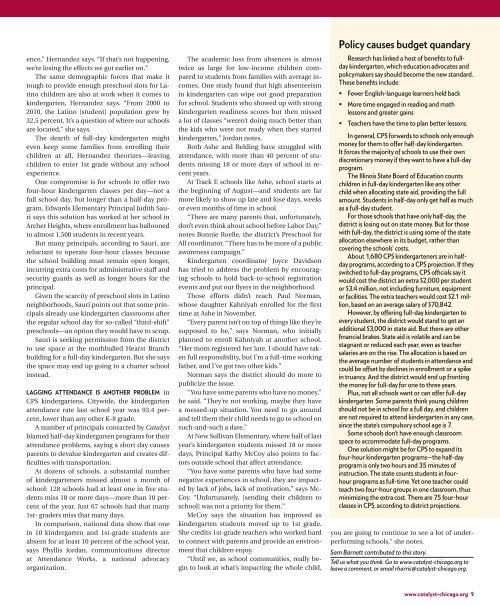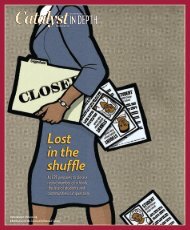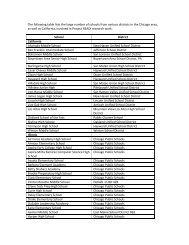The ABCs of kindergarten - catalyst-chicago.org
The ABCs of kindergarten - catalyst-chicago.org
The ABCs of kindergarten - catalyst-chicago.org
Create successful ePaper yourself
Turn your PDF publications into a flip-book with our unique Google optimized e-Paper software.
ence,” Hernandez says. “If that’s not happening,<br />
we’re losing the effects we got earlier on.”<br />
<strong>The</strong> same demographic forces that make it<br />
tough to provide enough preschool slots for Latino<br />
children are also at work when it comes to<br />
<strong>kindergarten</strong>, Hernandez says. “From 2000 to<br />
2010, the Latino [student] population grew by<br />
32.5 percent. It’s a question <strong>of</strong> where our schools<br />
are located,” she says.<br />
<strong>The</strong> dearth <strong>of</strong> full-day <strong>kindergarten</strong> might<br />
even keep some families from enrolling their<br />
children at all, Hernandez theorizes—leaving<br />
children to enter 1st grade without any school<br />
experience.<br />
One compromise is for schools to <strong>of</strong>fer two<br />
four-hour <strong>kindergarten</strong> classes per day—not a<br />
full school day, but longer than a half-day program.<br />
Edwards Elementary Principal Judith Sauri<br />
says this solution has worked at her school in<br />
Archer Heights, where enrollment has ballooned<br />
to almost 1,500 students in recent years.<br />
But many principals, according to Sauri, are<br />
reluctant to operate four-hour classes because<br />
the school building must remain open longer,<br />
incurring extra costs for administrative staff and<br />
security guards as well as longer hours for the<br />
principal.<br />
Given the scarcity <strong>of</strong> preschool slots in Latino<br />
neighborhoods, Sauri points out that some principals<br />
already use <strong>kindergarten</strong> classrooms after<br />
the regular school day for so-called “third-shift”<br />
preschools—an option they would have to scrap.<br />
Sauri is seeking permission from the district<br />
to use space at the mothballed Hearst Branch<br />
building for a full-day <strong>kindergarten</strong>. But she says<br />
the space may end up going to a charter school<br />
instead.<br />
Lagging attendance is another problem in<br />
CPS <strong>kindergarten</strong>s. Citywide, the <strong>kindergarten</strong><br />
attendance rate last school year was 93.4 percent,<br />
lower than any other K-8 grade.<br />
A number <strong>of</strong> principals contacted by Catalyst<br />
blamed half-day <strong>kindergarten</strong> programs for their<br />
attendance problems, saying a short day causes<br />
parents to devalue <strong>kindergarten</strong> and creates difficulties<br />
with transportation.<br />
At dozens <strong>of</strong> schools, a substantial number<br />
<strong>of</strong> <strong>kindergarten</strong>ers missed almost a month <strong>of</strong><br />
school: 128 schools had at least one in five students<br />
miss 18 or more days—more than 10 percent<br />
<strong>of</strong> the year. Just 67 schools had that many<br />
1st- graders miss that many days.<br />
In comparison, national data show that one<br />
in 10 <strong>kindergarten</strong> and 1st-grade students are<br />
absent for at least 10 percent <strong>of</strong> the school year,<br />
says Phyllis Jordan, communications director<br />
at Attendance Works, a national advocacy<br />
<strong>org</strong>anization.<br />
<strong>The</strong> academic loss from absences is almost<br />
twice as large for low-income children compared<br />
to students from families with average incomes.<br />
One study found that high absenteeism<br />
in <strong>kindergarten</strong> can wipe out good preparation<br />
for school. Students who showed up with strong<br />
<strong>kindergarten</strong> readiness scores but then missed<br />
a lot <strong>of</strong> classes “weren’t doing much better than<br />
the kids who were not ready when they started<br />
<strong>kindergarten</strong>,” Jordan notes.<br />
Both Ashe and Belding have struggled with<br />
attendance, with more than 40 percent <strong>of</strong> students<br />
missing 18 or more days <strong>of</strong> school in recent<br />
years.<br />
At Track E schools like Ashe, school starts at<br />
the beginning <strong>of</strong> August—and students are far<br />
more likely to show up late and lose days, weeks<br />
or even months <strong>of</strong> time in school.<br />
“<strong>The</strong>re are many parents that, unfortunately,<br />
don’t even think about school before Labor Day,”<br />
notes Bonnie Roelle, the district’s Preschool for<br />
All coordinator. “<strong>The</strong>re has to be more <strong>of</strong> a public<br />
awareness campaign.”<br />
Kindergarten coordinator Joyce Davidson<br />
has tried to address the problem by encouraging<br />
schools to hold back-to-school registration<br />
events and put out flyers in the neighborhood.<br />
Those efforts didn’t reach Paul Norman,<br />
whose daughter Kahniyah enrolled for the first<br />
time at Ashe in November.<br />
“Every parent isn’t on top <strong>of</strong> things like they’re<br />
supposed to be,” says Norman, who initially<br />
planned to enroll Kahniyah at another school.<br />
“Her mom registered her late. I should have taken<br />
full responsibility, but I’m a full-time working<br />
father, and I’ve got two other kids.”<br />
Norman says the district should do more to<br />
publicize the issue.<br />
“You have some parents who have no money,”<br />
he said. “<strong>The</strong>y’re not working, maybe they have<br />
a messed-up situation. You need to go around<br />
and tell them their child needs to go to school on<br />
such-and-such a date.”<br />
At New Sullivan Elementary, where half <strong>of</strong> last<br />
year’s <strong>kindergarten</strong> students missed 18 or more<br />
days, Principal Kathy McCoy also points to factors<br />
outside school that affect attendance.<br />
“You have some parents who have had some<br />
negative experiences in school, they are impacted<br />
by lack <strong>of</strong> jobs, lack <strong>of</strong> motivation,” says Mc-<br />
Coy. “Unfortunately, [sending their children to<br />
school] was not a priority for them.”<br />
McCoy says the situation has improved as<br />
<strong>kindergarten</strong> students moved up to 1st grade.<br />
She credits 1st-grade teachers who worked hard<br />
to connect with parents and provide an environment<br />
that children enjoy.<br />
“Until we, as school communities, really begin<br />
to look at what’s impacting the whole child,<br />
Policy causes budget quandary<br />
Research has linked a host <strong>of</strong> benefits to fullday<br />
<strong>kindergarten</strong>, which education advocates and<br />
policymakers say should become the new standard.<br />
<strong>The</strong>se benefits include:<br />
• Fewer English-language learners held back<br />
• More time engaged in reading and math<br />
lessons and greater gains<br />
• Teachers have the time to plan better lessons.<br />
In general, CPS forwards to schools only enough<br />
money for them to <strong>of</strong>fer half-day <strong>kindergarten</strong>.<br />
It forces the majority <strong>of</strong> schools to use their own<br />
discretionary money if they want to have a full-day<br />
program.<br />
<strong>The</strong> Illinois State Board <strong>of</strong> Education counts<br />
children in full-day <strong>kindergarten</strong> like any other<br />
child when allocating state aid, providing the full<br />
amount. Students in half-day only get half as much<br />
as a full-day student.<br />
For those schools that have only half-day, the<br />
district is losing out on state money. But for those<br />
with full-day, the district is using some <strong>of</strong> the state<br />
allocation elsewhere in its budget, rather than<br />
covering the schools’ costs.<br />
About 1,680 CPS <strong>kindergarten</strong>ers are in halfday<br />
programs, according to a CPS projection. If they<br />
switched to full-day programs, CPS <strong>of</strong>ficials say it<br />
would cost the district an extra $2,000 per student<br />
or $3.4 million, not including furniture, equipment<br />
or facilities. <strong>The</strong> extra teachers would cost $2.1 million,<br />
based on an average salary <strong>of</strong> $70,842.<br />
However, by <strong>of</strong>fering full-day <strong>kindergarten</strong> to<br />
every student, the district would stand to get an<br />
additional $3,000 in state aid. But there are other<br />
financial brakes. State aid is volatile and can be<br />
stagnant or reduced each year, even as teacher<br />
salaries are on the rise. <strong>The</strong> allocation is based on<br />
the average number <strong>of</strong> students in attendance and<br />
could be <strong>of</strong>fset by declines in enrollment or a spike<br />
in truancy. And the district would end up fronting<br />
the money for full-day for one to three years.<br />
Plus, not all schools want or can <strong>of</strong>fer full-day<br />
<strong>kindergarten</strong>. Some parents think young children<br />
should not be in school for a full day, and children<br />
are not required to attend <strong>kindergarten</strong> in any case,<br />
since the state’s compulsory school age is 7.<br />
Some schools don’t have enough classroom<br />
space to accommodate full-day programs.<br />
One solution might be for CPS to expand its<br />
four-hour <strong>kindergarten</strong> programs—the half-day<br />
program is only two hours and 35 minutes <strong>of</strong><br />
instruction. <strong>The</strong> state counts students in fourhour<br />
programs as full-time. Yet one teacher could<br />
teach two four-hour groups in one classroom, thus<br />
minimizing the extra cost. <strong>The</strong>re are 75 four-hour<br />
classes in CPS, according to district projections.<br />
you are going to continue to see a lot <strong>of</strong> underperforming<br />
schools,” she notes.<br />
Sam Barnett contributed to this story.<br />
Tell us what you think. Go to www.<strong>catalyst</strong>-<strong>chicago</strong>.<strong>org</strong> to<br />
leave a comment, or email rharris@<strong>catalyst</strong>-<strong>chicago</strong>.<strong>org</strong>.<br />
www.<strong>catalyst</strong>-<strong>chicago</strong>.<strong>org</strong> 9









